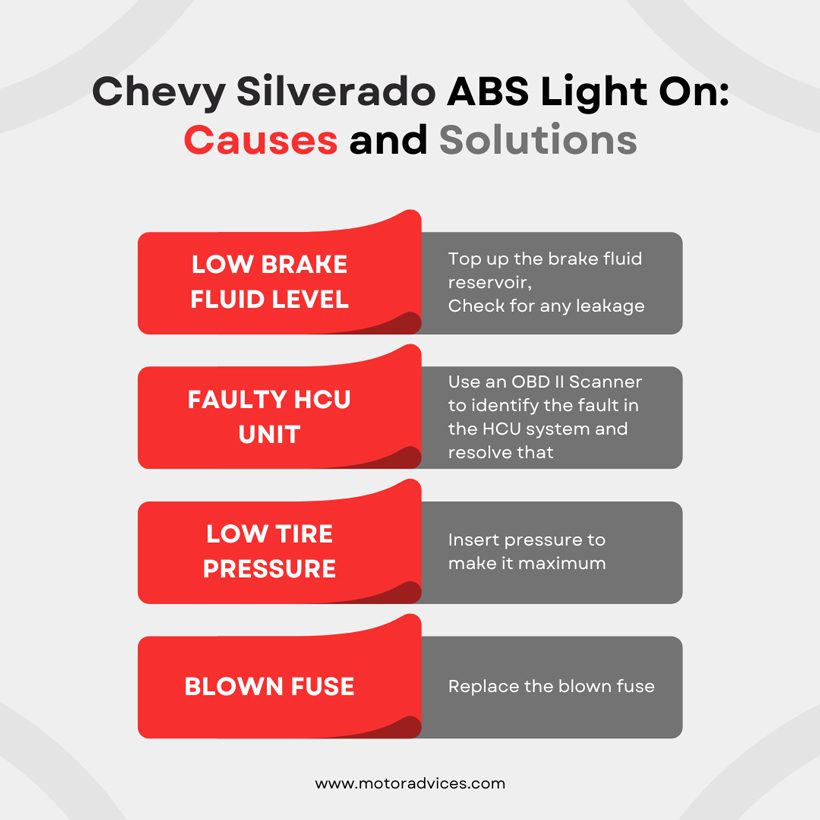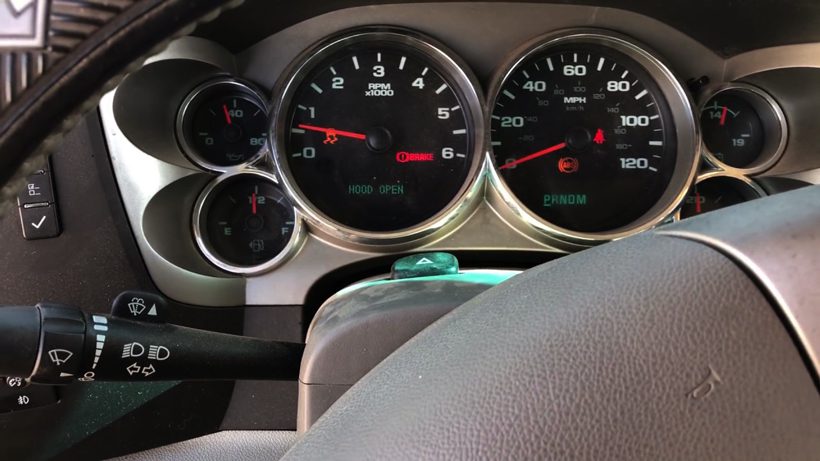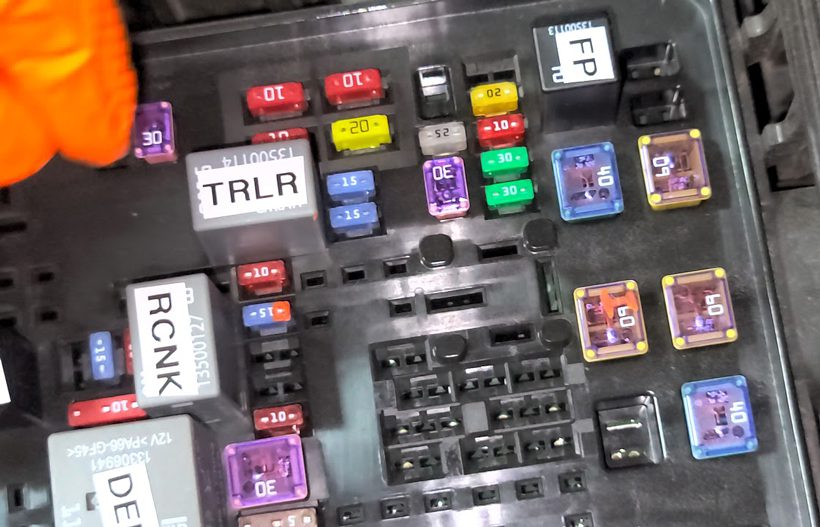Chevy Silverado ABS Light On: Common Causes and Resetting Solutions
The Chevy Silverado is equipped with various advanced technological features. Among these features, the Anti-lock Braking System is the prominent one. Unfortunately, it often hosts malfunction-related issues and constantly directs the ABS light’s illumination.
So why is the Chevy Silverado ABS light on? The Chevy Silverado anti-lock braking system’s light remains on for
- Low brake fluid level
- Faulty HCU unit
- Low pressure in tire(s)
- Blown fuse, etc.
To solve these, use an OBD II scanner to precisely detect and address the fault.
In this article, you are about to learn the common causes of Silverado ABS light along with the solutions. Also, we are going to inform you of ABS resetting solutions. So let’s get started!
Chevy Silverado ABS Light On: Causes and Solutions

| Causes | Solutions |
|---|---|
| Low brake fluid level | Top up the brake fluid reservoir |
| Check for any leakage | |
| Faulty HCU unit | Use an OBD II Scanner to identify the fault in the HCU system and resolve that |
| Low tire pressure | Insert pressure to make it maximum |
| Blown fuse | Replace the blown fuse |
Common Causes And Resetting Solutions for Chevy Silverado ABS Light On
When the Silverado’s ABS light illuminates the dashboard, it indicates that there is a fault in the system. We detail those faults and the resolving process.

Low Brake Fluid Level
The ABS’s effective function depends on the hydraulic pressure generated by the brake fluid. A low brake fluid level hosts a pressure drop that directs the ABS to compromise the system’s effectiveness.
This is how when the brake fluid level in your Silverado falls below the minimum threshold, it triggers the ABS warning light on the dashboard.
How to Solve
Below are actions you can take to solve the issue.
- Locate the white-colored brake fluid reservoir at the driver’s side under the hood.
- Open the reservoir cap.
- Pour in new brake fluid, and make it up to the maximum marking on the container.
- Check the ABS light condition.
- We also suggest you inspect the brake fluid reservoir and pipings to find any leakage. If there is any leak, seal that one.
Faulty HCU Unit
The Hydraulic Control Unit (HCU) is a crucial component of the Anti-lock Braking System in the Silverado. It regulates hydraulic pressure to the brakes during emergency braking situations.
The HCU, also known as the ABS pump, consists of electronic and mechanical-hydraulic mechanisms. The electronic mechanism accommodates sensors that continuously monitor wheel speed and send respective data to the control module.
On the other hand, the mechanical-hydraulic part comprises valves that control the brake fluid pressure to each wheel independently. If the ABS control module senses a possible wheel lockup, it transmits signals to the hydraulic component of the ABS compressor to open the valves.
In this way, the combined work of both mechanisms makes the ABS function in the case of extreme or sudden braking. As you see, the HCU unit is very complex, and if any component of the system receives a fault, the whole system fails to work properly, triggering the light to illuminate.

How to Solve
Below are the resolution approaches.
- Connect an OBD II scanner to the vehicle’s diagnostic port.
- Run a scan.
- Get the fault codes related to the ABS pump, like code 1095.
- Use a code reader to retrieve the codes. And address the issue.
- We also suggest you take professional help if you are not that good with OBD II Scanner fault code analysis.
- Lastly, if you are a DIY enthusiast, do physical check up of the whole ABS pump system.
Low Pressure in Tire
If your Silverado’s one of the wheels has low tire pressure, its diameter gets reduced. As a result, when the vehicle is rolling, the underinflated tire rotates at a different speed in comparison to other properly inflated tires.
Here, the ABS control module detects the speed difference and interprets it as a lock-up situation. Thus, the ABS light gets illuminated.
How to Solve
Here are the resolution approaches.
- Check the Tire Pressure Monitoring System’s warning light to identify the tire(s) with low pressure.
- Also, do the physical inspection of all the tires, including the spare one.
- Check for damage or leaks upon being confirmed about a particular tire with low tire pressure.
- Repair the damage or leaks.
- Insert pressure to reach till 35 psi.
Blown Fuse
The ABS fuse protects and controls the electrical components of the Anti-lock Braking System. It prevents excessive current flow. Most importantly, it protects sensitive electrical components from damage due to short circuits or current overloads.
Here, if the fuse is blown up due to excessive loading, you will see the ABS light remains on. Also, the fuse’s function depends on a series of connecting switches named relays. If there is a fault in the relay system, the ABS light remains on.

How to Solve
The following actions you should take to resolve the blown fuse and faulty relay issues.
- Use the manufacturer’s manual to identify the location of the fuse.
- You will see a burning sign or melted elements inside the fuse.
- Replace the fuse.
- Now check the relays’ condition.
- Upon finding any faulty one, replace that.
Faulty Wheel Speed Sensor
The Chevy Silverado’s each wheel hub is equipped with an ABS wheel speed sensor. These sensors measure the rotational speed of the respective wheels and send this data to the ABS control unit.
Over time, the sensor hosts defects due to encountering road debris, water, ice, extreme temperatures, etc. And the faulty condition triggers the ABS light illumination continuously.

How to Solve
Below are actions you can take to solve the issue.
- Connect the OBD II scanner to the vehicle’s diagnostic port.
- Run the scan.
- Collect the fault codes. For instance, you will get Code C0040.
- Use a code reader to retrieve wheel speed sensor issues.
- Upon issue identification, take appropriate actions. If the sensor is damaged, replace the sensor. And if there is a problem with the wire connection, repair the wire connection, etc.
Resetting The Chevy Silverado ABS
If you cannot find any fault mentioned above but still the ABS light is on, we suggest you go for resetting the Anti-lock Braking System. To turn off the ABS light in your Silverado, apply the methods below.

Resetting via OBD II Scanner
Below is the stepwise guide to reset the ABS with an OBD II Scanner.
Step 01: Stop and start the vehicle without driving. Check if the light goes off.
Step 02: If the light is still on, drive at 20 km per hour for at least 5 miles. Check the light again.
Step 03: If the light remains on, connect the OBD II Scanner to the vehicle’s diagnostic port.
Step 04: Turn on the engine and input the required information, like vehicle model and VIN.
Step 05: Run a scan to get fault code(s) and then do necessary repairs or replacements based on the code(s). In this case, the device will show you fault codes related to low brake fluid, faulty HCU, low tire pressure, etc. Solve these issues by employing the earlier mentioned resolutions.
Step 06: The light should be off after clearing the faults.
Check out this YouTube video to learn the use of an OBD II scanner:
ABS Resetting without OBD
Here is the step-by-step guide to reset the ABS without using an OBD II tool.
Step 01: Detach the positive battery cable.
Step 02: Press the brake and hold it to drain any remaining electricity.
Step 03: Wait a while to let Silverado’s central computer system reset.
Step 04: The ABS light should be gone once the resetting is done.
If the ABS light in your Chevy Silverado is causing you concern, rest assured – we’re here to assist you in unraveling the issue. Our article on Toyota Camry ABS light concerns may offer insights that resonate with your situation. Additionally, if you’re curious whether a low battery could be the cause of your ABS light coming on, our guide on can a low battery cause ABS light to come on provides the information you need. Safety on the road is paramount, and our comprehensive resources are designed to help you navigate and resolve any ABS-related challenges you might encounter.FAQs
Here, we answer some of the most common questions people also ask regarding the Silverado ABS light issue.
To be specific about the fault that the very first time, we suggest you use an OBD II Scanner. The OBD II scanner will collect and diagnose the error codes, pinpointing the problem area.
Yes, you can still drive your Silverado with the ABS light on. But we do not advise you to do that. It accommodates safety hazards during emergencies or on slippery roads.
Disconnecting the battery for a short period can reset the ABS light. But it is a temporary solution. If the root cause is not addressed, the ABS light will turn on again after some time.
Final Words
We expect that our detailing on the Chevy Silverado ABS light on solution guide will help you enormously. We suggest you follow the given troubleshooting approaches to diagnose and resolve the ABS light issue. You check the brake fluid level, tire pressure, ABS fuses, etc. to identify potential causes.
Also, you can use an OBD II scanner to get insight into the specific problem area. We see it as the most effective solution to address the causes of ABS light-on promptly. Finally, don’t be shy about taking help from a professional when you feel you can’t do it.

